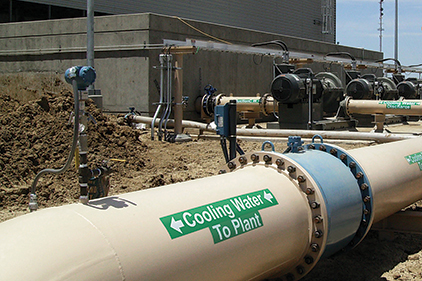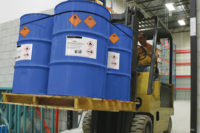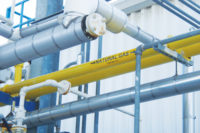Labeling pipes is one of the most important and labor-intensive tasks for mechanical contractors. Without labels, pipes become a lethal landmine for those performing underground maintenance and repairs. Roughly 80 percent of the labeling mechanical contractors do is pipe marking, according to an industry insider.
Custom communications
With tight deadlines and fierce competition for multi-year contracts, mechanical contractors are switching from buying pre-made signs and labels to creating their own custom visual communications onsite and on demand, because it’s impossible to predict what might happen on a jobsite. Today’s versatile industrial labeling systems generate just about every kind of sign and label to comply with ANSI, OSHA and other standards as well as company policies. Because pipes are exposed to oil and chemical spills, extreme temperatures and UV sunlight, pipe marking labels must be industrial-strength, yet easy to read from any distance.
Signage supports safety
Signs, labels and warning devices themselves alone do not prevent injury — safety programs and training are essential — but they do communicate critical information that result in workers making better safety decisions. It’s still vitally important to control exposure to the hazard and control the hazards themselves.
Promoting safe work habits at the job site, teaching newcomers the safe way to do a job and completing jobs safely are the three key responsibilities mechanical contractors deal with every day. Signs, labels and warning devices help mechanical contracting teams make intelligent choices — impacting both safety and quality control.
“We educate our trades to create a perimeter around construction zones and then add signage to detail the types of hazards,” said project manager Dave Straus, Trade-Mark Industrial Inc., a mechanical contractor based in Ontario, Canada. “Keeping people away from high-risk activities that our workers complete on a regular basis is critical.”
Act now
When is the best time to launch a visual communications program to support safety and efficiency goals? The quick answer is now…
• Before facility renovations and expansion
• Before new hires come onboard
• Before new standards like GHS are enforced or ANSI Z535 changes occur
• Before you’ve invested in new machinery
• Before inspections
• Before corporate mergers
• Before the next environmental disaster
• Before your company and workers are exposed to liability
• Before labels are worn and not readily visible
In addition to compromising the health and well-being of team members, co-workers, friends and family, companies that do a poor job with safety may face increased insurance costs.
“Workplace safety programs affect a company’s experience modification which in turn helps determine insurance costs,” explained Keith McNally, Strategic Business Services. “The workers’ compensation experience modification plan helps insurance companies charge companies for insurance programs based upon historical loss experience. The more companies manage risk through safety signs, labels and warning devices, the less insurance companies will charge to insure risks.”







